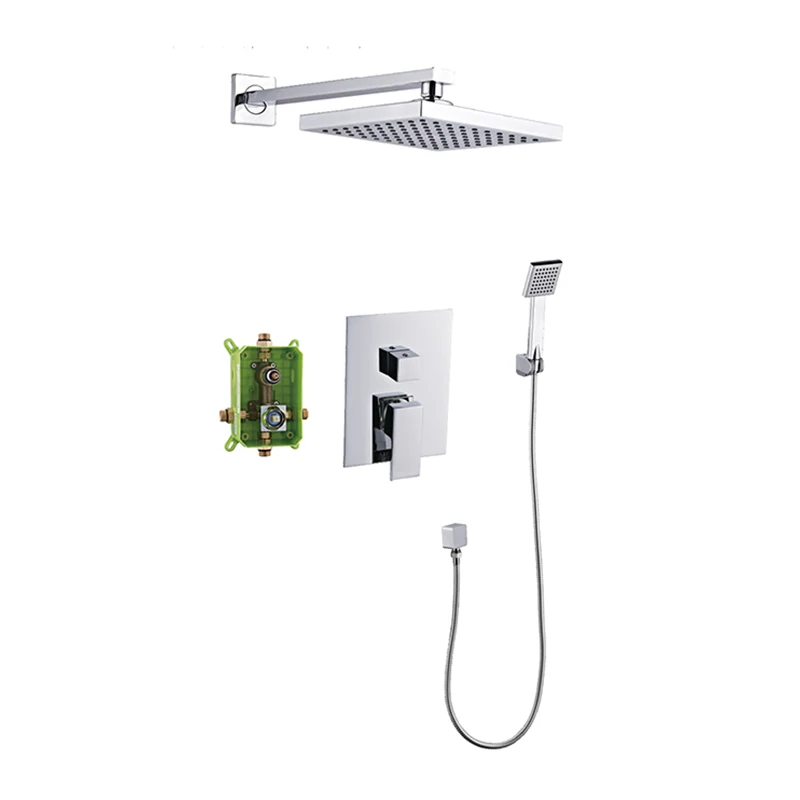As the core component of the bathroom system, shower faucets can be divided into multiple types according to different materials, structures, and functions. Different types have significant differences in adaptation scenarios and usage requirements. When choosing, you need to consider the bathroom conditions and living habits comprehensively.

Full copper cast faucets are the mainstream in the market. This type of shower faucet has excellent corrosion resistance and a service life of up to 10-15 years, which is suitable for families pursuing durability. Its lead precipitation is ≤5μg/L, which meets the drinking water safety standards and is the preferred choice for the elderly and children.
Stainless steel faucets are mainly made of 304 materials, do not contain lead elements, have strong corrosion resistance, and are suitable for areas with hard water (pH value > 8.5), but are 30% heavier than copper faucets, and walls need to be reinforced during installation. Alloy faucets are affordable (about 1/3 of full copper products) but have a high lead content and a service life of only 3-5 years, which is suitable for short-term transitional use.
The split faucet separates the control valve body from the water outlet component. The top spray, hand shower, and lower water outlet can be adjusted independently. The height adjustment range of the top spray is up to 20cm. The hose length is usually 1.5 meters. It is suitable for bathrooms with complex house types or flexible layouts. The wall water pipe pre-buried error is compatible within ±5cm. Later maintenance only requires replacing the corresponding module.
The integrated faucet integrates the valve core and the water outlet structure into a whole. The installation is simple and suitable for standardized bathrooms in newly built houses. The pipeline is more beautiful when concealed, but the whole needs to be disassembled when replaced. The maintenance cost is 60% higher than the split type. The wall-mounted faucet valve body is hidden inside the wall, and only the control panel is exposed. It is more concise visually and suitable for minimalist style bathrooms, but the installation requires pre-buried pipelines in advance, and the transformation is more difficult.
The hot and cold dual-control faucet is a basic model. The hot and cold water are adjusted separately by two handles. The water temperature needs to be manually balanced. It is suitable for families with limited budgets. The thermostatic faucet has a built-in paraffin or memory alloy valve core, which can stabilize the water temperature at the set value (usually 38-42℃). When the water inlet pressure fluctuates, it automatically compensates within 0.5 seconds to avoid hot and cold, which is especially suitable for old communities with unstable water pressure and families with elderly people and children.
Smart faucets have added touch, voice control or APP linkage functions, which can preset water temperature and time off. Some models are equipped with water flow metering functions to help monitor water consumption, which is suitable for users who pursue technological experience. Faucets with water-saving aerators (water flow and air mixing ratio 1:3) save 30% more water than ordinary products, and the flow rate is controlled within 2.5L/min, which meets the national secondary water-saving standards.
Exposed faucets do not require pre-buried pipelines, and the valve body is exposed outside the wall. The installation is simple and suitable for the renovation of old houses, but the aesthetics are slightly inferior. The concealed faucet valve body is embedded in the wall, with only the operation panel and the water outlet exposed. It looks neat and tidy, suitable for new house decoration, but it needs to be pre-buried during the water and electricity renovation stage. Later maintenance requires the wall to be demolished, which is costly.
The wall-mounted hand-held faucet buries the water supply pipe into the wall, and the hand-held shower can be directly fixed on the wall, saving space and suitable for small-sized bathrooms; the top-spray integrated faucet combines the top spray with the control part, and the installation height is usually 2.1-2.3 meters, suitable for taller users.
For special needs, there are also anti-scalding faucets (automatically limit flow when the water temperature exceeds 45℃), low-pressure special faucets (adapted to 0.05-0.8MPa water pressure), solar compatible faucets (temperature difference resistance - 10℃ to 80℃) and other sub-products on the market. For example, rural self-built houses are suitable for low-pressure faucets, and secondary water supply users in high-rise residential buildings can give priority to voltage-stabilizing products.
Understanding the differences in shower faucets and considering factors such as bathroom space, water quality, and family composition can help you choose a product that combines practicality and cost-effectiveness to create a comfortable shower experience.
